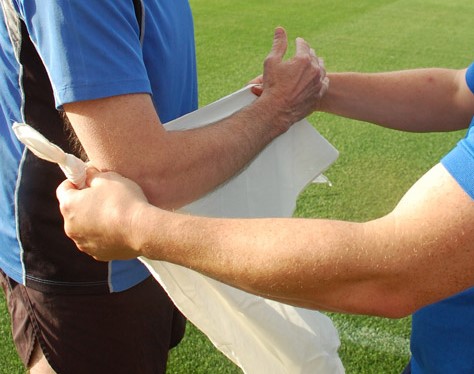
First Aid: how to make an arm sling
An arm sling holds the forearm in a raised or horizontal position and can support an injured upper arm, forearm and wrist. The sling is also a useful visual warning to others that someone is injured
Arm sling:
- Support injured arm.
- Place bandage under arm.
- Meet the ends by shoulder of injured arm and tie.
- Secure sling and check circulation.
Arma Sling, What to do
- Arm sling – point of triangle should be underneath elbow, with long side under the hand
Ask the casualty to support their arm with their other hand. Gently slide the triangular bandage underneath the arm. The point of the triangle should be underneath the elbow of the injured arm. Bring the top end of the bandage around the back of the neck.
- Arm sling – fold lower end up over the forearm to the neck, same side as injury
Fold the lower end of the bandage up over the forearm to meet the top of the bandage at the shoulder of the injured side.
- Arm sling – tie two ends together in reef knot
Tie the two ends of the bandage together in a reef knot above their collar bone and tuck in the free ends.
- Arm sling – adjust the sling to support the arm all the way to their little finger
Adjust the sling so that it supports their arm all the way to the end of their little finger.
- Arm sling – twist and tuck in edge of bandage by elbow
Make sure that the edge of the bandage by the elbow is secured by twisting the fabric and tucking it in, or using a safety pin to fasten.
- Arm sling – check circulation in fingertips
Check the circulation in their fingertips every 10 minutes. Press their nail for 5 seconds until it turns pale, then release to see if the colour returns within 2 seconds.
Read Also:
Emergency Live Even More…Live: Download The New Free App Of Your Newspaper For IOS And Android
First Aid, Fractures (Broken Bones): Find Out What To Look For And What To Do
Treating Injuries: When Do I Need A Knee Brace?
Wrist Fracture: How To Recognise And Treat It
Carpal Tunnel Syndrome: Diagnosis And Treatment
Knee Ligament Rupture: Symptoms And Causes
Lateral Knee Pain? Could Be Iliotibial Band Syndrome
Knee Sprains And Meniscal Injuries: How To Treat Them?
Stress Fractures: Risk Factors And Symptoms
What Is OCD (Obsessive Compulsive Disorder)?
RICE Treatment For Soft Tissue Injuries
P.O.L.I.C.E. Vs R.I.C.E.: The Emergency Treatment For Acute Injuries
How And When To Use A Tourniquet: Instructions For Creating And Using A Tourniquet
Bone Callus And Pseudoarthrosis, When The Fracture Does Not Heal: Causes, Diagnosis And Treatment


